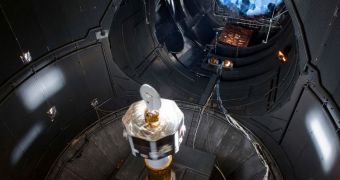Officials with the European Space Agency (ESA) announce that the full-scale version of the upcoming Mercury mapper BepiColombo has just been tested at the agency's Large Space Simulator (LSS), the only facility in the world capable of reproducing Mercury's conditions at such a large scale.
ESA will lead the new mission, which will seek to assess the conditions that exist in Mercury's hellish environment. This is precisely what the LSS did for the spacecraft, but with a different purpose.
The tests were meant to see whether the spacecraft could withstand the temperatures characterizing the closest planet to the Sun. The probe's sunshield, which was developed in Europe, withstood temperature levels exceeding 350 degrees Celsius.
Japan contributes to BepiColombo by providing the octagonal Mercury Magnetospheric Orbiter (MMO), whereas ESA provides the critically-important sunshield. But the heat is not necessarily the mission's most brutal enemy.
As it approaches Mercurial orbit, as well as after it enters it, the spacecraft will be battered with up to ten times the amount of radiation a satellite orbiting around Earth is subjected to regularly.
During the new tests, the LSS was able to simulate these radiation levels, and mission managers were reassured that the spacecraft will hold. The Simulator is located at the European Space Research and Technology Center (ESTEC), in the Netherlands.
“Previously, the LSS was capable of simulating a solar constant or two. Now it has been upgraded to produce ten solar constants,” the ESA BepiColombo project manager, Jan van Casteren, says of a uni that solar physicists use to measure the power of the Sun.
The unit describes how much energy is received per second on a surface measuring a square meter, located at a given distance from Earth's orbit. ESTEC boosted the LSS' power by operating its radiation lamps at full power, and also by installing mirrors to adjust and focus the beams.
“The sunshield test was successful. Its function to protect the MMO spacecraft during the cruise phase was demonstrated,” says Jan.
“The tests allowed us to measure the thermal blanket’s performance. The results allow us to prepare some adjustments for the tests of the Mercury Planetary Orbiter next year,” the expert adds
“BepiColombo consists of separate modules. The MMO will investigate the magnetic environment of Mercury. It is kept cool during its six-year cruise to Mercury by the sunshield. These are the two modules that have now completed their thermal tests,” ESA says in a press release.

 14 DAY TRIAL //
14 DAY TRIAL //